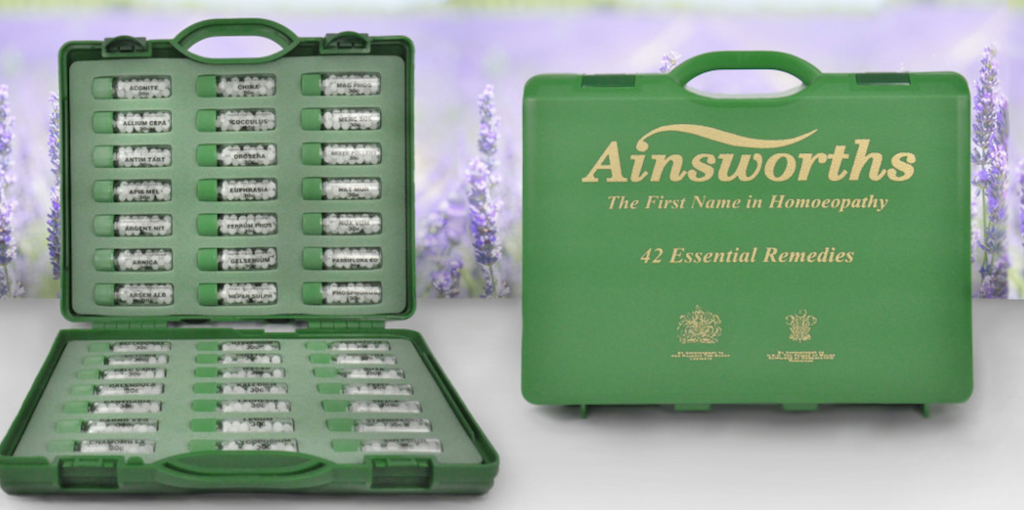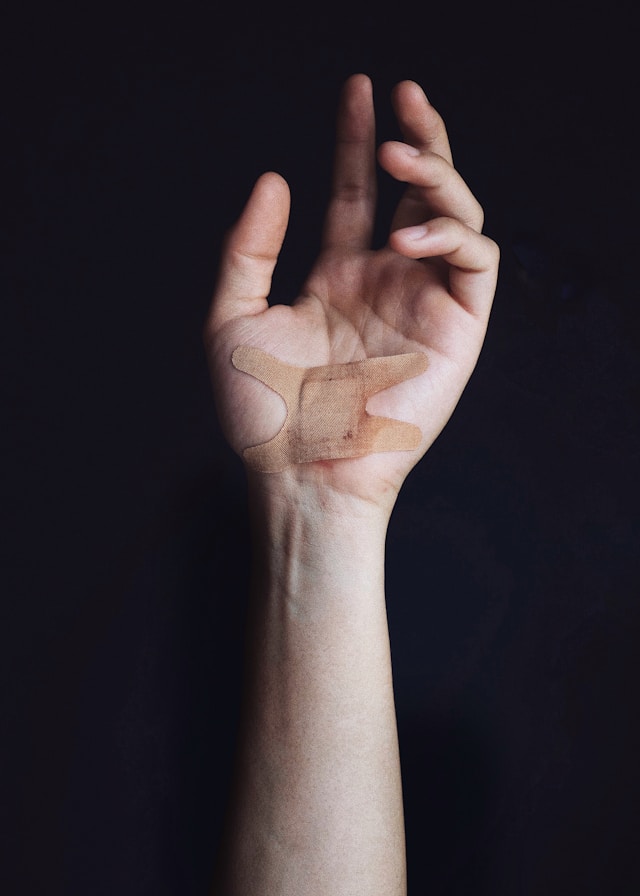More on Homeopathy First Aid Kits. Whilst with care and attention accidents can be avoided, the unfortunate fact is that bumps and scapes are a fact of life, for adults and children alike. Please note that for many minor things the body will heal quite naturally, so use your medicines judiciously.
Within your first-aid kit you will find several in medicines in the class of ‘vulneraries’, these being suitable for the treatment of wounds to tissues (and feelings). For ‘vulneries’ think vulnerable (same word root).

Within your first-aid kit you will find several in medicines in the class of ‘vulneraries’, these being suitable for the treatment of wounds to tissues (and feelings). For ‘vulneries’ think vulnerable (same word root).
Looking at my Ainsworth Kit (see below), I find Apis; Arnica; Calendula; Cantharis; Chamomilla; Hypericum; Ignatia; Ledum; Rhus toxicodendron; Ruta graveolens; Staphysagria.

For more on the benefits of purchasing a first aid kit of basic homeopathic remedies see my earlier blog Family Care with Homeopathy
Classical homeopathic prescribing considers the following:
Consider homeopathic treatment like finding the right key for a lock, if after a taking the remedy for a short while (say one tablet or pill three to four times a day for 1-2 days) there is no response, then try another.
The task in classical homeopathic prescribing is to match the charateristics of the remedy or medicine with the symptoms of the patient. The symptoms reflect the body’s attempt to cure. The homeopathic remedy echoes those symptoms and stimulates an immune response. This is the principle of ‘like curing like’ (which is what the word Homeopathy means). Properly applied you will get better quicker.
Remember that homeopathic medicines are absorbed through the mucous membranes of the mouth – not the gut – so you let the tablet or pill dissolve under the tongue.
In Homeopathy First Aid Kits you will find several in medicines in the class of ‘vulneraries’, these being suitable for the treatment of wounds to tissues (and feelings).
Looking at my Ainsworth Kit, I find Apis; Arnica; Calendula; Cantharis; Chamomilla; Hypericum; Ignatia; Ledum; Rhus toxicodendron; Ruta graveolens; and Staphysagria.
Derived from the sting of the bee. Its affinity is for the skin, mucous (moist inner lining of organs) and serous (outer lining of organs) membranes. Red, puffy (oedema) and burning might be the key words. It is useful in rapidly developing conditions like tonsillitis, laryngitis, conjunctivitis and urinary troubles where there is a burning sensation. Think of apis also in rheumatism when the joint is shiny red and swollen. Ice cold applications ameliorate (e.g. suck ice with a sore throat).
Derived from a small mountain plant with yellow flowers. Many have heard of this medicine, possibly in its use as a herbal salve. Its primary use homeopathically is in the healing of soft tissue damage where there is bruising. Another odd characteristic is that people make light of their suffering: “don’t fuss, I am fine”. Arnica will benefit those unaccustomed to exercise who suffer from overuse of the muscles and joints. Arnica types do not like to be touched. It even has value in the treatment of influenza (particularly in athletes).
Don’t apply Arnica in herbal form to an open wound as a rash may develop (use Calendula instead – see below)
Here is a short video of the masterful Prof. George Vithoulkas talking about arnica. The video and sound quality are not great but the guidance is! Prof Vithoulkas is now 92 but still a leading light in homeopathy today. He teaches that this remedy should not be used for minor bruises, rather more serious events where there is real pain or even suspected concussion.
Curiously, the memory of past trauma can benefit from Arnica – possibly years past. I attended a lecture where Prof. Vithoulkas opened a patient’s case with Arnica because her health troubles began many years previously after she had been badly assaulted by a step-father.
Interesting fact: Arnica like Calendula and Chamomilla are all members of the daisy plant family (Compositae). The common daisy (Bellis Perrenis) has similar properties to Arnica though not usually in any first aid kit. Botanical families of plants often share common charactistics.
Derived from the Marigold. This is another substance that can be used externally as a herbal salve and internally in homeopathic potency. It promotes the healing of open wounds including ulcers. You could dissolve one pill from the kit in a little water and dab that on the wound and also take it internally. You can buy Calendula ointment, and also tincture (10% solution in alcohol / water) for external use. Think of Calendua when you might otherwise use Savlon or Germolene.
Derived from a small beetle (Lytta vesicatoria) otherwise know as Spanish Fly (though it is neither a fly nor unique to Spain!). The keyword here is burning pains. Consequently there is overlap with Apis. Its focus is on the genitourinary tract. Think of this remedy in cases of cystitis where there is a constant urge to urinate with burning. As you might expect it is useful first aid following scalds potentially with blistering. On the mental sphere there may be irritation to the point of rage.
Most people have heard of Chamomile tea and its soothing effect. Homeopathically it sits with a group of medicines that display suffering out of proportion to the condition. The chief characteristic is anger. The inconsolable and demanding teething baby – driving the parent also to despair – often responds well to Chamomilla. Everything is simply intolerable. A remedy to be considered for toothache, colic, ear infection and even pains of labour.
Derived from the plant St John’s Wort. Should you have the misfortune to jam your fingers in a door think of Hypericum. This is a medicine for lacerations where there is nerve damage. It can usefully be used alongside Calendula and indeed ointments containing both are useful in the first aid chest (sometimes called Hyper-cal). Painful damage to the coccyx will respond well to Hypericum. It can also be useful in the treatment of haemorrhoids (piles).
The wounds of Ignatia are primarily emotional. This is a remedy for emotional shock resulting from bereavement, disappointment or distress. Moods can swing from from one extreme to the other. There may be spasm and loss of self control. This remedy should aid a return to equilibrium. Unlike Chamomilla there is no anger or violence.
Derived from the wild rosemary (sage family) this medicine is used to wounds that often have a small point of entry. So useful in stings and bites or a stab from a nail (it has reputed anti-tetanus properties) or vaccinations. The books speak of the wounds being ‘cold’ or better from cold applications. This leads me to think that Apis is better for a bee sting (if hot and swollen), but I confess no personal experience in this. Try one and if no result try the other!
It is also beneficial should you receive a black eye (so compatible with Arnica).
It can be of benefit in rheumatism (which begins in the lower limbs and ascends), and gout. Inflammation of a ligament in the sole of foot (plantar fasciitis) can often respond to this remedy also.
Derived from a Poison Ivy found in the Asia and North America. Another ‘swords to ploughshare remedy’. This medicine is particularly useful in conditions where there is muscle, ligament and tendon damage. The key modality is worse on the first movement and improves with continued movement (also better from warmth). The Rhus tox patient is never comfortable for long and continually has to change position. It is a remedy that often follows Arnica to good effect.
It is worth saying that this medicine has many spheres of action. Contact with Poison ivy results in blisters and itching and consequently Rhus tox can be useful is such as Chicken pox or Shingles. Rhus tox can also help resolve a dry cough that is worse at night preventing sleep.
It is not really possible in Homeopathy to say what any medicine is ‘for’ as they often are ‘for’ many things – but there are affinities.
Derived from the herb Rue, this medicine sits close to Rhus tox. as it acts on the muscles, tendons, cartilage and joints. Like Rhus it is better for movement. It also has an affinity with eye strain (ocular muscles). The bruised sensation makes comparison with Arnica. Homeopathic chemists can supply Arnica, Rhus tox and Ruta in combination (ARR) given the overlapping characteristics. The first aid kits tend to have these medicines individually but it is perfectly possible to take them in alternation or sequentially.
Derived from a plant related to delphinium this is another remedy for wounds. This time clean incised wounds such as post surgery which are proving slow to heal. Recurrent styes may also be helped with this medicine. Equally the ‘wounds’ can be emotional often associated with a sense of victimisation.
Think of the above medicines in a self-help context to promote healing. If healing is slow it is worth giving me a call to see if one of the these remedies or another can help speed up the natural process.
